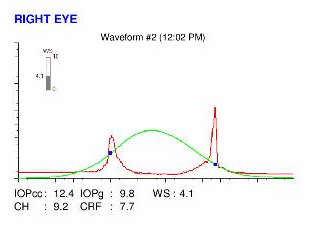Patient right profile
Case #94
The patient

Unilateral Asymmetric Keratoconus induced by eye rubbing
Identity : Mr M.K
First visit : 09/03/2013
Last Visit : 10/17/2017
Mr. M.K is a 39-year-old male with no previous medical history or any known family history of keratoconus. He complained of a progressive decrease in visual acuity greater in the right eye than the left.
His refraction at the first visit at the Rothschild Foundation (on 09/03th/2017) was : Right Eye (RE) 20/25 with+0.25 (-2.5 x 70 °) and Left Eye (LE) 20/20 with -0.5 (-0.75 x 115 °).
Clinical examination with the slit lamp suggested a thin and irregular right cornea with Fleischer ring. Fleischer rings are pigmented rings in the peripheral cornea, resulting from iron deposition in basal epithelial cells, in the form of hemosiderin.
Corneal topography performed at our institution showed the presence of a unilateral keratoconus, in the right eye
At the first visit, when asked about the possibility of frequent eye rubbing, the patient admitted to rubbing his eyes when he awoke in the mornings or when working in front of the computer because he enjoyed it.
He is left handed but rubbed his right eye with his right hand. The patient sleeps on his right side, with the head buried in the pillow (pillow hugging)
We explained to the patient that since vigorous rubbing had preceded the drop in visual acuity, this habit may have caused the cornea to deform, leading to the classic clinical presentation of keratoconus in his case.
We strongly advised this patient to stop rubbing his eyes and to change his unhealthy sleeping position.
Here are pictures of the patient rubbing his eyes and his profiles
Here a video of patient rubbing his right eye with knuckles
Here are the Orbscan quadmaps, OPD scans and Ocular Response Analyzer (ORA) results of the first visit .
Difference maps have been performed at each subsequent visit. No evolution has been observed between the first and last visit. The keratoconus is still stable, more than 49 months after the patient has definitely stopped to rub his eyes .
In this case we find many triggers for eye rubbing like extended computer work and an unhealthy sleeping position. The unilateral or asymmetric nature of keratoconus development may be related to the sleeping position (right sided) and the habit of preferentially rubbing the right eye.
The contralateral eye shows a forme fruste keratoconus. The patient admitted to rubbing both eyes, but the right eye more aggressively (because of the itch caused by eczema). His left cornea has an early form of keratoconus because the rubbing is less frequent and vigorous in this eye. This reinforces the hypothesis that eye rubbing, which preceded the onset of keratoconus in this case, is the root cause of it.
From our clinical experience, we notice the existence of families of » eye rubbers » with keratoconus. Given the environmental and genetic heritage of atopy and thin corneas, there can be many within the same family (parents-children, brothers or sisters) who tend to rub their eyes. Depending on the habits of each individual, and the intensity and duration of eye rubbing, the appearance and evolution of keratoconus can be variable.
This case is very informative and demonstrative of the causal effects of eye rubbing in the pathogenesis of keratoconus. Cross-linking is unnecessary in this case, as stabilisation of the corneal deformation was achieved with the simple act of cessation of eye rubbing.
As demonstrated again in this clinical example, the cessation of eye rubbing and patient education are the best tools in the prevention of the genesis and/or evolution of keratoconus.
Other cases :
- Date 23 octobre 2018
- Tags Allergy, Asymmetric, Bilateral keratoconus, Eye rubbing, Knuckles rubbing, Male, Night shift, Sleep position, Stabilization, Work rubbing
























